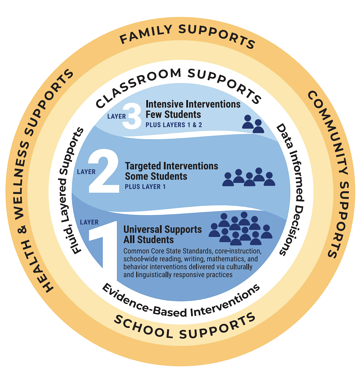Districts across the country are using a multi-tiered system of supports (MTSS) framework to create systems of care that ensure students get what they need, academically and behaviorally.
MTSS, an acronym for “multi-tiered system of supports,” is an organizational framework used in education settings to ensure that all students’ needs are met through increasingly targeted interventions across three levels of support. As educators build intervention plans, they use data to help them make well-informed decisions that will produce the best outcomes for each student.
In this comprehensive guide, we’ll take a deeper look at what makes up an MTSS, how it works, and some examples of schools and districts using the framework to support students and educators.
Table of Contents:
- MTSS: A Framework for Every Student
- The Key Components of MTSS
- Getting to Know the MTSS Framework
- The Power of Data-Based Decision-Making
- How to Implement MTSS in Your District
- A Dedicated MTSS Team
- Using MTSS to Support the Whole Child
- Next Steps for Strengthening Your District’s MTSS
What is MTSS?
A multi-tiered system of supports (MTSS) provides a guiding, comprehensive framework for educators, school, and district leaders. This framework allows K-12 educators to:
- Remove barriers to learning at the systems level.
- Use evidence-based practices to ensure all students are learning at grade-level.
- Make data-based decisions for targeted and intensive interventions.
An MTSS framework helps unify practices across a district, so students are getting the same access to support no matter what school or classroom they are in.
Classroom educators, counselors, and administrators are all working towards a common goal: creating a positive learning environment that serves the needs of all students across all areas of development. By using data as a guide to inform initiatives, they can ensure that their choices are grounded in actual student need, not just educator perception. Looking at data consistently also allows educators to take preventative steps to intervene before larger challenges arise.
|
|
The Key Components of MTSS
Without a solid framework or guiding plan, it’s difficult to implement practices consistently and sustainably. Systems can vary a lot from school to school within a district, or even classroom to classroom. This can lead to inconsistency and can mean that students aren’t getting access to the support that they need.
Every district’s MTSS is unique depending on individual context, but there are a few essential components that make up an MTSS:
In this section, you’ll learn more about these components and how they work together to make up the MTSS framework.
Use our Interventions and Progress Monitoring Toolkit
What are the Tiers of the MTSS Framework?
The multi-tiered system of supports framework consists of three tiers of support. Students are given access to the support they need across academics, attendance, behavior, and life skills. This access is provided using universal screening and progress monitoring data to start a student in the least intensive support environment, and adding or removing that support as needed.

An example of the MTSS pyramid
Traditionally, the MTSS framework is visualized as a three-tiered pyramid, though visual aids may vary from district to district. For example, some school districts, like Portland Public Schools (OR), are shifting towards an “inverted” MTSS pyramid to convey the importance of Tier 1 universal supports.
Some districts choose to use other visual models entirely. The New Mexico Public Education Department created a graphic composed of different circles encompassed by rings as a model for their multi-layered system of supports (MLSS) framework. This image incorporates the three layers, as well as guiding themes and key drivers.

Example: A model of the MLSS framework from the MLSS Implementation Guide from the New Mexico Public Education Department.
While the supports within each tier may look different from district to district, there are certain commonalities for every MTSS pyramid. Let’s take a closer look at what goes on at each tier.
Tier 1
Educators often refer to Tier 1 supports as “universal” because they are provided to every student. Strong Tier 1 practices are essential for strengthening school climate, relationships, and classroom instruction. Examples of Tier 1 supports include:
- High-quality core instruction.
- Embedding life skills into curriculum and assessment.
- Cultivating a positive and inclusive school climate.
Many school districts create Tier 1 school climate teams or embed Tier 1 supports into school improvement planning.
|
Pro Tip: Emphasizing a strong Tier 1 through a positive and inclusive school climate also drives equity. Check that your Tier 1 is truly inclusive by investigating the following questions:
|
Tier 2
Tier 2 supports are targeted, additional interventions delivered to students who are not responding to Tier 1 supports. Typically, around 15 to 20% of students will receive Tier 2 support, which are often given in small group settings.
Schools often convene Student Support Teams (SST), Student Intervention Teams (SIT), or Child Study Teams (CST) to identify at-risk students who need Tier 2 support and use data from multiple domains to determine appropriate interventions. Many schools establish data "cut points” across academics, behavior, attendance, and life skills to determine when a student needs to receive Tier 2 interventions.
Tier 3
Tier 3 supports refer to intensive services that 1 to 5% of students receive if they continue to struggle and require even more support. It is also for students who are undergoing more of an acute crisis, such as the death of a parent.
|
Pro Tip: Ensuring educators have access to a library of strong, evidence-based interventions is crucial for supporting students. Districts and schools that partner with Panorama have access to Playbook, a professional learning library for K-12 educators. Playbook includes 1,000+ MTSS interventions across academics, attendance, behavior, and well-being that support students at every tier and every developmental stage. |
Recommended Resource: 42 MTSS Interventions for Your Student Support Team
The Power of Data-Based Decision-Making
Once you have a tiered intervention structure, data plays a crucial role in determining when and how to deploy resources and intervention strategies.
Schools and districts following an MTSS structure use universal screening processes and assessment systems to identify which students need targeted supports. MTSS interventionists then use data across academic performance, behavior, attendance, and life skills to source the right intervention strategy from a whole-child perspective.
The practice of data-based decision-making and documentation of MTSS interventions can also support the reduction of bias in schools. By interrogating data, educators can uncover disparities in interventions provided based on race, ethnicity, or other student group identifiers that could lead to over-referrals for discipline or special education.
More and more districts are adopting system-wide MTSS data systems like Panorama for Student Success to drive continuous improvement and monitor student outcomes. A central system can support educators and administrators by:
- Triangulating student data to better understand root causes of present challenges.
- Enabling collaboration around interventions to support student needs.
- Monitoring the progress of individual and group intervention plans over time.
- Providing year-over-year student data as students move from elementary school to middle school to high school, preventing them from slipping through the cracks during key transitions.

Panorama’s data dashboards allow teachers to track student growth and identify areas in need of intervention. (Please note that demo data is pictured.)
Recommended Resource: 3 Questions Every Data-Driven MTSS Support Team Must Ask Weekly [Download]
How to Implement MTSS in Your District
Implementing a district-wide framework can feel overwhelming. An MTSS is a large and complex system, touching all aspects of school life. But there are certain elements that will set your district up for success:
- Having a dedicated MTSS team
- Building community collaboration and buy-in
- Planning for continuous improvement
In this section, we’ll take a closer look at how each of these elements contributes to a strong and sustainable MTSS.
Recommended Resource: Creating an MTSS Implementation Plan: 6 Keys for Success
A Dedicated MTSS Team
Because MTSS is, by definition, a system-wide practice, school district leaders support effective MTSS practices through communicating a unified vision. Support for MTSS must begin at the district level and should include long-term planning, program evaluation, resource allocation to schools, and professional development.
Kimberly Lawson, Director of Special Education at Special School District in Mehlville, MO, shared powerful insights on her district’s approach to building buy-in for MTSS:
“MTSS work needs to start at the central office in order to be implemented district-wide, and building-level teams need extra support during the first few years… Ensuring our buildings were supported was one of the best decisions that we made as a team. Any way that districts can figure out how to coach and how to support, they should.”
Having a dedicated MTSS team signals that MTSS is a priority in your district, and helps clarify roles and responsibilities when it comes to implementation. Teams can also evaluate the fidelity of implementation and intervention efficacy. Here are some examples of who may be involved in an MTSS team, depending on whether they work at a district or school level:
- District-Level Team Members:
- A Director of MTSS leads the development of a data-based, district-wide MTSS. Directors are responsible for collaborating closely with building administrators, educators, support staff, families, and students.
- An MTSS Coordinator works closely with the Director of MTSS and is responsible for communicating with schools in the district, developing meeting schedules, documenting processes, monitoring progress, and providing professional development resources.
- School-Based Team Members:
- MTSS teams are made up of individual adults in the school and look at data, develop interventions, and create support plans for students who need them. Ideally, a team should include a school administrator, a teacher from each grade level, and a mental health professional.
- School-based teams are led by an MTSS Coach. This person works with individual schools and works with administrators, teachers, and counselors to coordinate tiered interventions. They also work closely with other school MTSS coaches to form a strong network within the district.
Recommended Resource: MTSS Job Descriptions to Build Out Your Team
A Community of Collaboration
Implementing a system as complex and far-reaching as an MTSS framework requires collaboration and cooperation with every member of the school community. This extends not only to the educators and staff members within your district, but also to students and their families. A system works best when everyone works together. Here are some ways you can invite members of your district community to participate in MTSS implementation:
- Provide opportunities for professional development on MTSS topics for educators.
- Identify and elevate members of your district community who are passionate about MTSS.
- Share resources, new research, and news through school newsletter.
- Elevate student, educator, and family voices through feedback surveys.
- Engage families and caregivers in all aspects of their children’s education.
- Provide community members with visibility into your MTSS processes, particularly around data collection, usage, and privacy.
Recommended Resource: 360° Climate Surveys Starter Pack
A Cycle of Continuous Improvement
MTSS implementation is ever-evolving. As a school community's needs change, your MTSS will need to evolve to reflect those changes. A commitment to continuous improvement can help an MTSS progress.
One of the best ways to understand what’s working (and what isn’t) within your district is to conduct surveys with different groups in your community. Gathering feedback from students, families, teachers, and staff will give you insight into what their experiences are like in your district, and ways that you could potentially improve those experiences. Understanding community needs can be especially helpful when planning district and school-wide Tier 1 supports.
If you want a deeper understanding of your district’s MTSS, consider using an MTSS self-assessment tool to get feedback from the educators in your district so you can take action to build a better MTSS.
Recommended Resource: MTSS Self-Assessment
Using MTSS To Deliver Holistic Support
Because MTSS is designed to support all aspects of learning, it also strongly aligns with other initiatives and systems. MTSS works together with:
- PBIS
- RTI
- Life Skills
- Special Education Services
MTSS and PBIS
Positive Behavioral Interventions and Supports (PBIS) and MTSS are different, but they are related and work well together. It may be easiest to think of PBIS as the behavior component of a larger MTSS that encompasses behavior, academics, and life skills.
|
|
PBIS, like MTSS, uses a tiered model of intervention support. Tier 1 PBIS interventions are used for all students to create positive environments for learning. If individuals or groups of students need more support, more targeted interventions are used at Tiers 2 and 3. These tiers often involve support from counselors and other specialists.
PBIS also relies on collecting and analyzing Big 5 data to inform decisions and guide interventions. Different schools will have different approaches to positive behavioral interventions. Examples of positive behavior interventions include token reward systems and using behavior-specific praise to encourage desired behaviors.
Recommended Resource: PBIS Team Toolkit
MTSS and RTI
The MTSS framework is closely related to the Response to Intervention (RTI) model, though not entirely the same.
RTI emerged from the reauthorization of the Individuals with Disabilities Education Act (IDEA) in 2004 as a process for determining the effect of tiered interventions on student academic learning. In an RTI model, educators identify students who may need extra academic or behavioral support. Students are then provided with interventions at increasing levels of intensity, usually through a special education department or program
The MTSS framework incorporates aspects of RTI. A multi-tiered system of supports is a holistic system ultimately designed to remove academic, behavioral, and other barriers, and to meet the needs of all learners to become college and career ready. Whereas RTI focuses on identifying individual student needs, MTSS focuses on creating systemic conditions of support, ensuring that the educational environment allows students to succeed.
MTSS and Life Skills
An important priority for many districts is supporting students holistically through life skills development. The MTSS framework encompasses this work with its focus on supports across life skills, well-being, academics, and behavior.
Life skills help students acquire and apply the knowledge, skills, and attitudes necessary to develop healthy identities, manage emotions, achieve goals, have supportive relationships, and make responsible and caring decisions. Examples of life skills include:
- Self-Awareness
- Self-Management
- Social Awareness
- Relationship Skills
- Responsible Decision-Making
MTSS and Special Education Services
MTSS can help get students the support they need without having to refer them to special education services, and can help identify which students should be assessed for disability and special education services.
While targeted interventions, particularly at Tiers 2 and 3, can align with special education services, MTSS is designed to serve all students, which is inclusive of students receiving special education services. Because MTSS allows students to receive support at multiple tiers at once, a student receiving special education services may be getting Tier 1 interventions in some areas and Tier 2 or 3 in others.
When looking at MTSS data, it’s important to understand the impacts your system and practices are having on students receiving special education services to ensure that they are receiving an equitable education.
Recommended Resource: MTSS and Special Education: Nurturing Effective Alignment and Collaboration
|
Frequently Asked Questions: What is the role of technology in supporting MTSS implementation? Technology plays a crucial role in supporting MTSS implementation by facilitating data collection, analysis, and communication among stakeholders. Digital platforms and tools enable educators to collect and track student data, monitor progress, and evaluate the effectiveness of interventions in real-time. Additionally, technology allows for the customization of interventions, delivery of online resources, and remote collaboration, making MTSS more accessible and adaptable to diverse learning environments. How does MTSS address the transition between grade levels or schools? MTSS emphasizes continuity and coordination of support across transitions between grade levels or schools to ensure a seamless educational experience for students. By sharing student data, intervention plans, and best practices among educators, MTSS promotes consistency and alignment of supports across different settings. Transition planning teams may collaborate to identify students' needs, develop transition plans, and provide targeted supports during critical transition periods, such as moving from elementary to middle school or high school. What role do parents and caregivers play in the MTSS process? Parents and caregivers are essential partners in the MTSS process. They contribute valuable insights into their child's strengths, challenges, and needs, which inform intervention planning and decision-making. Additionally, parents and caregivers can collaborate with educators to implement interventions at home and support their child's progress. MTSS promotes family engagement through regular communication, involvement in the intervention planning process, and access to resources and support services. What professional development opportunities are available to support educators in implementing MTSS? Various professional development opportunities are available to support educators in implementing MTSS effectively. These may include workshops, webinars, conferences, and online courses focused on MTSS principles, data-driven decision-making, tiered interventions, and evidence-based practices. Additionally, ongoing coaching, mentorship programs, and communities of practice provide educators with opportunities for peer collaboration, reflection, and continuous improvement in MTSS implementation. Districts may also invest in training resources and capacity-building initiatives to ensure that educators have the knowledge, skills, and support they need to successfully implement MTSS. |
Next Steps for Strengthening Your District’s MTSS
Figuring out how to best support students is a complex endeavor. We know, because we partner with 2,000 districts to navigate these challenges.
Whether you need support structuring an MTSS framework, consulting on a roll-out plan, or professional development, our team will be your partner and guide. We support thousands of schools and districts with their MTSS through feedback surveys and a robust MTSS data platform.
If you’re interested in learning more about how your district can partner with Panorama for MTSS, visit our website or schedule a demo with our team.
|
Resource List
|


.jpeg)

.png)


.webp?width=666&height=640&name=Interventions-Progress-Monitoring-Toolkit%20(dragged).webp)